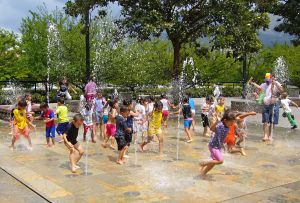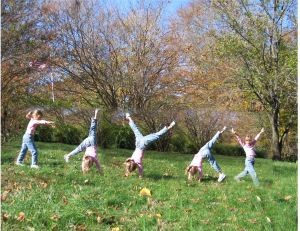by Craig Valency, MA, CSCS
Introduction
 As I discussed in my introductory post, the missing link to true movement mastery is learning the 9 perceptual-motor skills as early as possible.
As I discussed in my introductory post, the missing link to true movement mastery is learning the 9 perceptual-motor skills as early as possible.
As fitness professionals, teachers, therapists, or parents, we have a unique opportunity to even the playing field by offering every child we work with an ideal environment to explore movement through all their senses.
These skills lay the foundation for an increased movement vocabulary with overall better coordination and the ability to learn the fundamental movement skills. With this foundation firmly in place, children are better equipped and more likely to engage in sports and recreational activities for a lifetime.
Here is a bird’s eye view of the 9 perceptual-motor skills we’re looking at in this series:
- Body: Understand the parts of the bodies and how they move
- Directional: Differentiate between the left and right sides of the body and move in all planes of motion
- Spatial: Has a sense of how much space one’s body takes up and moves comfortably around other people and objects
- Temporal: Has a sense of timing and rhythm
- Visual: Can visually focus and track objects
- Vestibular: Develop an internal sense of their body’s position in relation to gravity
- Auditory: Can accurately respond to sound
- Tactile: Can respond to touch in competitive situations to counter a move, as in wrestling, or in cooperative situations to stay with a partner, as in dance
- Proprioceptive: Interpret the internal sense of where the body is in space
Today, I’ll focus on spatial awareness and discuss why it is so important to overall coordination and movement efficiency. I’ll outline what it is and give specific ideas that you can use to teach spatial awareness in any youth fitness program.
What is Spatial Awareness?
If you’ve spent time with young children, you’ve no doubt seen them bump into each other or run each other over. They don’t always sense when they are too close to another child or to you! They also don’t have an accurate understanding of their own height or width in relation to other people or objects, especially considering that their body dimensions are changing so rapidly in a short period of time.
Spatial awareness has some crossover with directional awareness, which is an internal knowledge of the left and right sides of the body, as well as an ability to correctly move in various directions and planes of motion.
Spatial awareness specifically refers to a child’s ability to understand how his or her body is oriented in space and the amount of space it occupies. It also relates to a child’s understanding of personal space (how much space his or her body occupies), the general space indoors or outdoors, and restricted spaces, where the child must remain within specific boundaries.
The development of spatial awareness involves an ability to understand relationships with other people and objects as well as being able to locate objects in relation to other objects.
- Subjective localization develops first; it is the ability to relate objects or other people in space to one’s own body, such as determining whether it’s necessary to turn sideways to fit between two chairs, for example
- Objective localization develops next; it is the ability to relate objects in space to other objects, such as determining whether one object would fit inside another, for example
Movement variables (MVs) are used to explore many of the parameters of spatial awareness. Movement variables include shapes the body can make, levels the body can move in, and pathways the body can take. The use of specific words to convey body positions and movement options in space are extremely important, and serves to increase both language skills and movement vocabulary.
The following movement variables (MV) table can be used to modify and explore all basic movement patterns and give children a frame of reference for the many possible ways their body can move in space.
| Effort | Space | Relationships |
| FORCE | LEVELS | OBJECTS |
| strong | high/med/low | over/under |
| light | between/among/around | |
| TIME | DIRECTIONS/ PATH | BODY PARTS |
| fast | forward/backward | narrow |
| slow | diagonal | wide |
| sustained | zig zag | curved |
| FLOW | RANGES | PEOPLE |
| free | self-space | mirror/matching |
| bound | general space | partners/solo |
Teaching Spatial Awareness
The best way to begin is with a general warm-up or quick start instant activity. Have the kids move around each other in a general or restricted space using various locomotion patterns such as a walk, skip, jog, crawl, etc. Next, add variety using the MV chart [above] to vary the speed, levels, or direction of movements. For instance, “On my signal, everybody skip throughout the space marked by the cones, and try not to bump into each other.” “Now everybody skip as high as possible like a kangaroo, and make your body as wide as you can.” This is a great way to get the wiggles out while exploring an externally defined space as well as navigate around other kids.
Here are some other activities for a variety of skill levels.
- Airplanes: Have the kids put their arms out like airplanes as they “fly” around the general or restricted space, trying not to bump into other “planes.” They can bank and turn their planes as they choose.
- Helicopter spins: On your signal, have them spin like helicopters with their arms out as they circulate through the room.
- Bi-planes: Now have partners stand “wingtip to wingtip;” two kids must cooperate as one big plane and make sure they don’t run into other planes.
- Clouds & planes: In this version, have half the class on the floor creating small, medium, or large cloud shapes (they can make cloud shapes independently or with others), while the other students fly around the “clouds.” For an added challenge, have the “clouds” hold front or side plank or crab positions, or balance on one leg in various shapes.
- Cone jump calls: This is a great way to teach the concept of judging distances in relation to the body and an external object. Start by setting up a starting cone and a target cone (or simply use lines on the gym floor). Tell the children how many jumps or steps they must use to get to the cone. For instance, “Get to the cone in four jumps!” Then, without moving the cones, say, “Get to the cones in eight jumps!” This forces them to feel how far away the target cone is and subdivide the distance properly to get there.
- Guess the steps: Now, have them predict how many walking steps, marches, skips, or hops it would take to get to the cone. Change the distance each time so they can discover how accurate their guesses are.
- Obstacle course: This is a great way to improve movement efficiency and spatial awareness in relation to objects. Simply set up any small or large pieces of equipment, such as cones, hurdles, boxes, or hoola hoops in a random order and show them how to negotiate each item. For instance, they would have to crawl around the cones, jump over the hurdles, log roll to the box and climb over it, and finally, hop through the hoola hoops. Oftentimes, being able to get under, over, or around a barrier is just as much about judging the distance one must move and how much space the body takes up as it is about pure athletic ability.
- Tumbling:
 Another component of spatial awareness is creating a better understanding of where the body is in relation to the earth and sky. Am I right side up or upside down? Am I on my side? Tumbling, rolling, and cartwheels, as well as handstands or inverted balance positions, help kids feel comfortable being in positions that take them out of familiar relationships with the outside environment. Tumbling also helps a child recover more quickly when he or she falls or rolls while engaging in sports or playing.
Another component of spatial awareness is creating a better understanding of where the body is in relation to the earth and sky. Am I right side up or upside down? Am I on my side? Tumbling, rolling, and cartwheels, as well as handstands or inverted balance positions, help kids feel comfortable being in positions that take them out of familiar relationships with the outside environment. Tumbling also helps a child recover more quickly when he or she falls or rolls while engaging in sports or playing.
Conclusion
The key to teaching spatial awareness to children is to create an understanding of how much space the body takes up in relation to other people and objects. Locomotion activities that require kids to move around each other are a great start. Use the movement variable chart to create new ways to move and experience how the body relates to others. Creatively teach ways to help kids more accurately judge distances. Set up an obstacle course to help kids move more efficiently and better understand how much space they actually take up. Finally, tumbling activities are a challenging and fun way to create a greater awareness of where the body is in relation to the outside environment.
In part 5, I’ll talk about temporal awareness, which refers to internal timing, tempo, and rhythm. I’ll talk about ways to help kids improve their understanding of rhythm and timing. I’ll also explain how temporal awareness leads to increased coordination and athletic performance as well as surprising improvements in academic performance!
Craig Valency, MA, CSCS, president and co-founder of SPIDERfit, has been a personal trainer for the last 11 years. He is currently working at Fitness Quest 10 in San Diego, an elite personal training and athletic conditioning facility. He specializes in youth strength and conditioning programs that promote physical literacy, injury prevention and optimal performance. Along with training youths from 6 to 18 years of age for general fitness, Craig has also worked with some of the top junior tennis players in the world. He has been a physical education consultant for the Stevens Point school district in Wisconsin for the last 3 years, helping revamp the district wide programming for the K-12 PE curriculum. Craig earned his bachelor degree from UCLA, and Masters Degree in Kinesiology from San Diego State University.






Would you include falling as an aspect of Spatial Awareness?
Christopher, that is a great question. Falling can be the effect of one or a combination of sensory awareness issues. Spatial awareness is certainly one aspect, where a child is constantly unable to judge how he or she relates to other people or objects around him or her. Other internal sensory issues could be at play, such as vestibular awareness, where the sense of balance is affected due to inner ear issues. Proprioceptive awareness can also be an issue, as this is the internal sense of where the joints and body parts are in space. I hope this helps. Thanks for your interest!